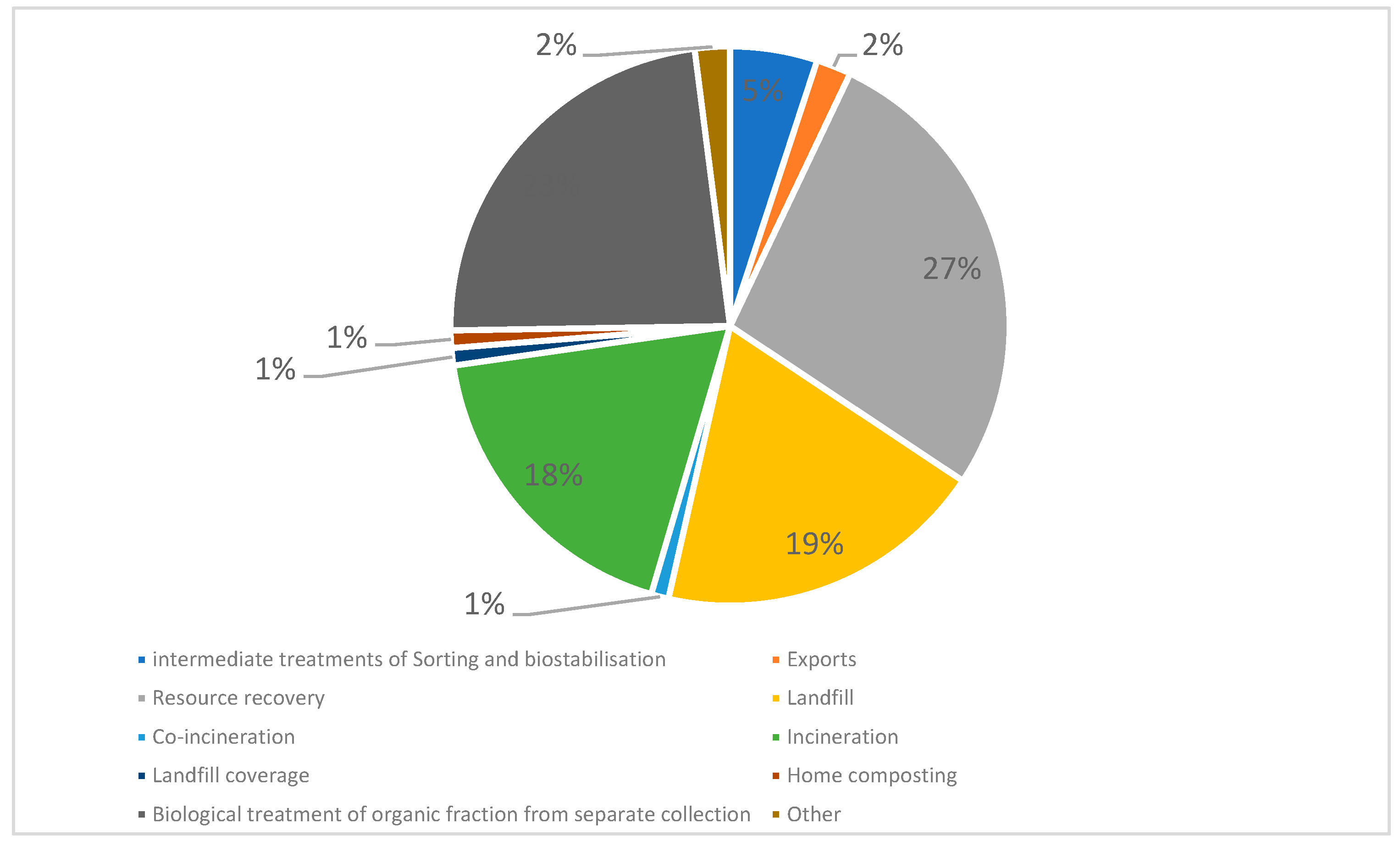Assessment of Energy, Mobility, Waste, and Water Management on Italian Small Islands
Abstract
1. Introduction
2. Materials and Methods
2.1. Data Collection
2.2. Data Analysis
3. Results
3.1. Energy
3.2. Mobility
3.3. Waste Management
3.4. Water
4. Discussion
4.1. Energy
4.2. Mobility
4.3. Waste
4.4. Water Management
4.5. General Consideration
5. Suggested Strategies for Enhancing Sustainability Extents
6. Conclusions
Supplementary Materials
Author Contributions
Funding
Data Availability Statement
Conflicts of Interest
References
- Cassin, L.; Melindi-Ghidi, P.; Prieur, F. Confronting Climate Change: Adaptation vs. Migration in Small Island Developing States. Resour. Energy Econ. 2022, 69, 101301. [Google Scholar] [CrossRef]
- Cartwright, J. Ecological Islands: Conserving Biodiversity Hotspots in a Changing Climate. Front. Ecol. Environ. 2019, 17, 331–340. [Google Scholar] [CrossRef]
- Russell, J.C.; Kueffer, C. Island Biodiversity in the Anthropocene. Annu. Rev. Environ. Resour. 2019, 44, 31–60. [Google Scholar] [CrossRef]
- Ali, E.; Cramer, W.; Carnicer, J.; Georgopoulou, E.; Hilmi, N.; Le Cozannet, G.; Lionello, P. Cross-Chapter Paper 4: Mediterranean Region. In Climate Change 2022: Impacts, Adaptation and Vulnerability. Contribution of Working Group II to the Sixth Assessment Report of the Intergovernmental Panel on Climate Change; Pörtner, H.-O., Roberts, D.C., Tignor, M., Poloczanska, E.S., Mintenbeck, K., Alegría, A., Craig, M., Langsdorf, S., Löschke, S., Möller, V., et al., Eds.; Cambridge University Press: Cambridge, UK; New York, NY, USA, 2022; pp. 2233–2272. [Google Scholar]
- Diane, C.; Erika, M.; Evangelos, R.; Christoforos, P.; Antun, P.; Daniele, G.; Goran, K.; Davide, A.G. A Methodology for Energy Planning in Small Mediterranean Islands, the Case of the Gozo Region. In Proceedings of the 2019 1st International Conference on Energy Transition in the Mediterranean Area (SyNERGY MED), Cagliari, Italy, 28–30 May 2019; IEEE: Piscataway, NJ, USA, 2019; pp. 1–6. [Google Scholar]
- Kougias, I.; Szabó, S.; Nikitas, A.; Theodossiou, N. Sustainable Energy Modelling of Non-Interconnected Mediterranean Islands. Renew. Energy 2019, 133, 930–940. [Google Scholar] [CrossRef]
- Lam-González, Y.E.; García, C.; González Hernández, M.M.; León, C.J. Benefit Transfer of Climate Change Adaptation Policies in Island Tourist Destinations. Tour. Manag. 2022, 90, 104471. [Google Scholar] [CrossRef]
- Major, D.C.; Blaschke, P.; Gornitz, V.; Hosek, E.; Lehmann, M.; Lewis, J.; Loehr, H.; Major-Ex, G.A.; Pedersen Zari, M.; Vásquez Vargas, M.J.; et al. Adaptation to Climate Change in Small Island Settlements. Ocean Coast. Manag. 2021, 212, 105789. [Google Scholar] [CrossRef]
- NESOI | New Energy Solutions Optimized for Islands. Available online: https://www.nesoi.eu/ (accessed on 7 July 2023).
- European Commission. Clean Energy 4 EU Islands. Available online: https://energy.ec.europa.eu/topics/markets-and-consumers/clean-energy-eu-islands_en (accessed on 3 March 2021).
- Frydrychowicz-Jastrzębska, G. El Hierro Renewable Energy Hybrid System: A Tough Compromise. Energies 2018, 11, 2812. [Google Scholar] [CrossRef]
- Godina, R.; Rodrigues, E.M.G.; Matias, J.C.O.; Catalão, J.P.S. Sustainable Energy System of El Hierro Island. Renew. Energy Power Qual. J. 2015, 1, 46–50. [Google Scholar] [CrossRef]
- Mena-Nieto, A.; Estay-Ossandon, C.; dos Santos, S.P. Will the Balearics and the Canary Islands Meet the European Union Targets for Municipal Waste? A Comparative Study from 2000 to 2035. Sci. Total Environ. 2021, 783, 147081. [Google Scholar] [CrossRef]
- Curto, D.; Favuzza, S.; Franzitta, V.; Musca, R.; Navarro Navia, M.A.; Zizzo, G. Evaluation of the Optimal Renewable Electricity Mix for Lampedusa Island: The Adoption of a Technical and Economical Methodology. J. Clean. Prod. 2020, 263, 121404. [Google Scholar] [CrossRef]
- Doorga, J.R.S. Climate Change and the Fate of Small Islands: The Case of Mauritius. Environ. Sci. Policy 2022, 136, 282–290. [Google Scholar] [CrossRef]
- Istituto Nazionale di Statistica (ISTAT). Demografia in Cifre. Available online: https://demo.istat.it/ (accessed on 11 April 2022).
- Istituto Nazionale di Statistica (ISTAT). Principali Statistiche Geografiche Sui Comuni. Available online: https://www.istat.it/it/archivio/156224 (accessed on 11 April 2022).
- Automobil Club d’Italia Automobil Club d’Italia Database. Available online: www.aci.it (accessed on 20 April 2022).
- Office International de l’Eau European Commission Urban Waste Water Website—Italy 2013. Available online: https://uwwtd.eu/Italia/content/home-page (accessed on 29 April 2022).
- Agrillo, A.; Dal Verme, M.; Liberatore, P.; Lipari, D.; Lucido g Maio, V.; Serace, V. (Eds.) Rapporto Statistico 2020 Energia Da Fonti Rinnovabili in Italia (Gestore dei Servizi Energetici S.p.A.—Direzione Studi, Monitoraggio e Relazioni Internazionali—Funzione Statistiche e Monitoraggio Target). March 2022.
- ISPRA Data Elaboration from the Catasto Nazionale Rifiuti 2019. Available online: https://www.catasto-rifiuti.isprambiente.it (accessed on 3 May 2022).
- Decree of Ministry of Economic Development of the 14 February 2017. Coverage of the Needs of the Smaller Islands Not Interconnected through Energy from Renewable Sources. Available online: https://www.mise.gov.it/images/stories/normativa/decreto_ministeriale_14_febbraio_2017_energia_isole_minori.pdf (accessed on 13 March 2002).
- Kuang, Y.; Zhang, Y.; Zhou, B.; Li, C.; Cao, Y.; Li, L.; Zeng, L. A Review of Renewable Energy Utilization in Islands. Renew. Sustain. Energy Rev. 2016, 59, 504–513. [Google Scholar] [CrossRef]
- European Union. REPowerEU Plan, COM(2022) 230 Final; European Commission: Brussels, Belgium, 2022. [Google Scholar]
- Fit for 55. Available online: https://www.consilium.europa.eu/en/policies/green-deal/fit-for-55-the-eu-plan-for-a-green-transition/ (accessed on 7 July 2023).
- The Data on Power from Renewable Energy Sources. Installed in Italy’s Small Islands Have Been Collected by the Authors through a Specific Request to the GSE (Italian Energy Services Manager) in 2022.
- A European Green Deal. Available online: https://commission.europa.eu/strategy-and-policy/priorities-2019-2024/european-green-deal_en (accessed on 7 July 2023).
- Groppi, D.; Astiaso Garcia, D.; Lo Basso, G.; De Santoli, L. Synergy between Smart Energy Systems Simulation Tools for Greening Small Mediterranean Islands. Renew. Energy 2019, 135, 515–524. [Google Scholar] [CrossRef]
- El Hierro Was Inserted in Best Practices by European Union—DG Environment. World’s First Energy Sufficient Island 2014. Available online: https://ec.europa.eu/environment/europeangreencapital/first-energy-sufficient-island/ (accessed on 1 September 2022).
- Berna-Escriche, C.; Vargas-Salgado, C.; Alfonso-Solar, D.; Escrivá-Castells, A. Can a Fully Renewable System with Storage Cost-Effectively Cover the Total Demand of a Big Scale Standalone Grid? Analysis of Three Scenarios Applied to the Grand Canary Island, Spain by 2040. J. Energy Storage 2022, 52, 104774. [Google Scholar] [CrossRef]
- Mutani, G.; Santantonio, S.; Brunetta, G.; Caldarice, O.; Demichela, M. An Energy Community for Territorial Resilience: Measurement of the Risk of an Energy Supply Blackout. Energy Build. 2021, 240, 110906. [Google Scholar] [CrossRef]
- European Commission. Clean Energy for All Europeans Package. 2018. Available online: https://energy.ec.europa.eu/topics/energy-strategy/clean-energy-all-europeans-package_en (accessed on 29 December 2022).
- European Parliament. Directive (EU) 2018/2001 of the European Parliament and of the Council of 11 December 2018 on the Promotion of the Use of Energy from Renewable Sources (RED II); European Parliament: Strasbourg, France, 2018. [Google Scholar]
- European Parliament. Directive (EU) 2019/944 of the European Parliament and of the Council of 5 June 2019 on Common Rules for the Internal Market for Electricity and Amending Directive 2012/27/EU; European Parliament: Strasbourg, France, 2019. [Google Scholar]
- Iglesias, G.; del Río, P.; Dopico, J.Á. Policy Analysis of Authorisation Procedures for Wind Energy Deployment in Spain. Energy Policy 2011, 39, 4067–4076. [Google Scholar] [CrossRef]
- Raveendran, V.; Alvarez-Bel, C.; Nair, M.G. Assessing the Ancillary Service Potential of Electric Vehicles to Support Renewable Energy Integration in Touristic Islands: A Case Study from Balearic Island of Menorca. Renew. Energy 2020, 161, 495–509. [Google Scholar] [CrossRef]
- Maas, S.; Attard, M. Policies to Promote Cycling in Southern European Island Cities: Challenges and Solutions from Three ‘Starter’ Cycling Cities. Transp. Res. Procedia 2022, 60, 52–59. [Google Scholar] [CrossRef]
- Ramos-Real, F.J.; Ramírez-Díaz, A.; Marrero, G.A.; Perez, Y. Willingness to Pay for Electric Vehicles in Island Regions: The Case of Tenerife (Canary Islands). Renew. Sustain. Energy Rev. 2018, 98, 140–149. [Google Scholar] [CrossRef]
- Istituto Superiore per la Protezione e la Ricerca Ambientale (ISPRA). Rapporto Rifiuti Urbani, Edizione 2022; Istituto Superiore per la Protezione e la Ricerca Ambientale (ISPRA): Rome, Italy, 2022. [Google Scholar]
- Royle, J.; Jack, B.; Parris, H.; Elliott, T.; Castillo, A.C.; Kalawana, S.; Nashfa, H.; Woodall, L.C. Plastic Drawdown: A Rapid Assessment Tool for Developing National Responses to Plastic Pollution When Data Availability Is Limited, as Demonstrated in the Maldives. Glob. Environ. Chang. 2022, 72, 102442. [Google Scholar] [CrossRef]
- Morales, Javier Narea Sun, Wind and Water. The New El Hierro Island’s Allies, ITC—Instituto Tecnológico de Canarias Las Palmas de Gran Canaria, Canary Islands, Spain. 2001. Available online: http://www.globalislands.net/greenislands/docs/spain_El-Hierro-1.pdf (accessed on 13 September 2022).
- Giudici, F.; Castelletti, A.; Garofalo, E.; Giuliani, M.; Maier, H.R. Dynamic, Multi-Objective Optimal Design and Operation of Water-Energy Systems for Small, off-Grid Islands. Appl. Energy 2019, 250, 605–616. [Google Scholar] [CrossRef]
- Pérez, D.M.G.; Martín, J.M.M.; Martínez, J.M.G.; Sáez-Fernández, F.J. An Analysis of the Cost of Water Supply Linked to the Tourism Industry. An Application to the Case of the Island of Ibiza in Spain. Water 2020, 12, 2006. [Google Scholar] [CrossRef]
- HYDROUSA—Demonstration of Water Loops with Innovative Regenerative Business Models for the Mediterranean Region. Available online: https://www.hydrousa.org/ (accessed on 18 July 2023).
- United Nation. Paris Agreement; United Nation: New York, NY, USA, 2015. [Google Scholar]
- Serpell, O. Innovation in Isolation: Islands and the Energy Transition; Kleinman Center for Energy Policy: Philadelphia, PA, USA, 2020. [Google Scholar]
- Weir, T.; Kumar, M. Renewable Energy Can Enhance Resilience of Small Islands. Nat. Hazards 2020, 104, 2719–2725. [Google Scholar] [CrossRef] [PubMed]
- Georgiou, P.N.; Mavrotas, G.; Diakoulaki, D. The Effect of Islands’ Interconnection to the Mainland System on the Development of Renewable Energy Sources in the Greek Power Sector. Renew. Sustain. Energy Rev. 2011, 15, 2607–2620. [Google Scholar] [CrossRef]
- Alves, M.; Segurado, R.; Costa, M. Increasing the Penetration of Renewable Energy Sources in Isolated Islands through the Interconnection of Their Power Systems. The Case of Pico and Faial Islands, Azores. Energy 2019, 182, 502–510. [Google Scholar] [CrossRef]
- Eras-Almeida, A.A.; Egido-Aguilera, M.A. Hybrid Renewable Mini-Grids on Non-Interconnected Small Islands: Review of Case Studies. Renew. Sustain. Energy Rev. 2019, 116, 109417. [Google Scholar] [CrossRef]
- Milone, D.; Curto, D.; Franzitta, V.; Guercio, A.; Cirrincione, M.; Mohammadi, A. An Economic Approach to Size of a Renewable Energy Mix in Small Islands. Energies 2022, 15, 2005. [Google Scholar] [CrossRef]
- Mehrjerdi, H. Modeling and Optimization of an Island Water-Energy Nexus Powered by a Hybrid Solar-Wind Renewable System. Energy 2020, 197, 117217. [Google Scholar] [CrossRef]
- Polido, A.; João, E.; Ramos, T.B. Sustainability Approaches and Strategic Environmental Assessment in Small Islands: An Integrative Review. Ocean Coast. Manag. 2014, 96, 138–148. [Google Scholar] [CrossRef]
- Italian Government. National Resilience and Recovery Plan (Piano Nazionale Di Ripresa e Resilienza) (PNRR). Available online: https://www.governo.it/sites/governo.it/files/PNRR.pdf (accessed on 23 May 2023).
- Ministero dello Sviluppo Economico; Ministero dell’Ambiente e della Tutela del Territorio e del Mare. Piano Nazionale Integrato per l’Energia e Il Clima; Ministero delle Infrastrutture e dei Trasporti: Rome, Italy, 2019.
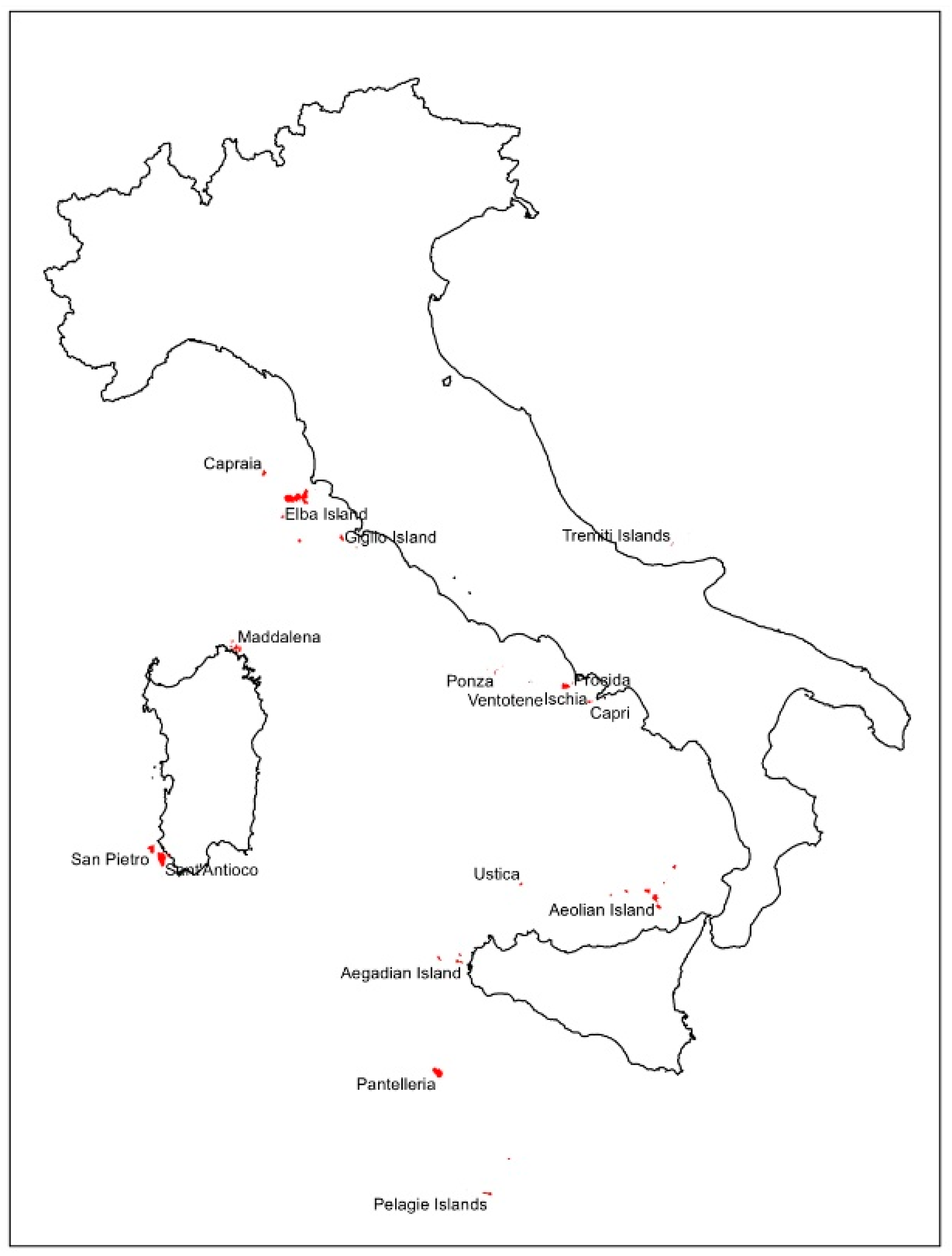
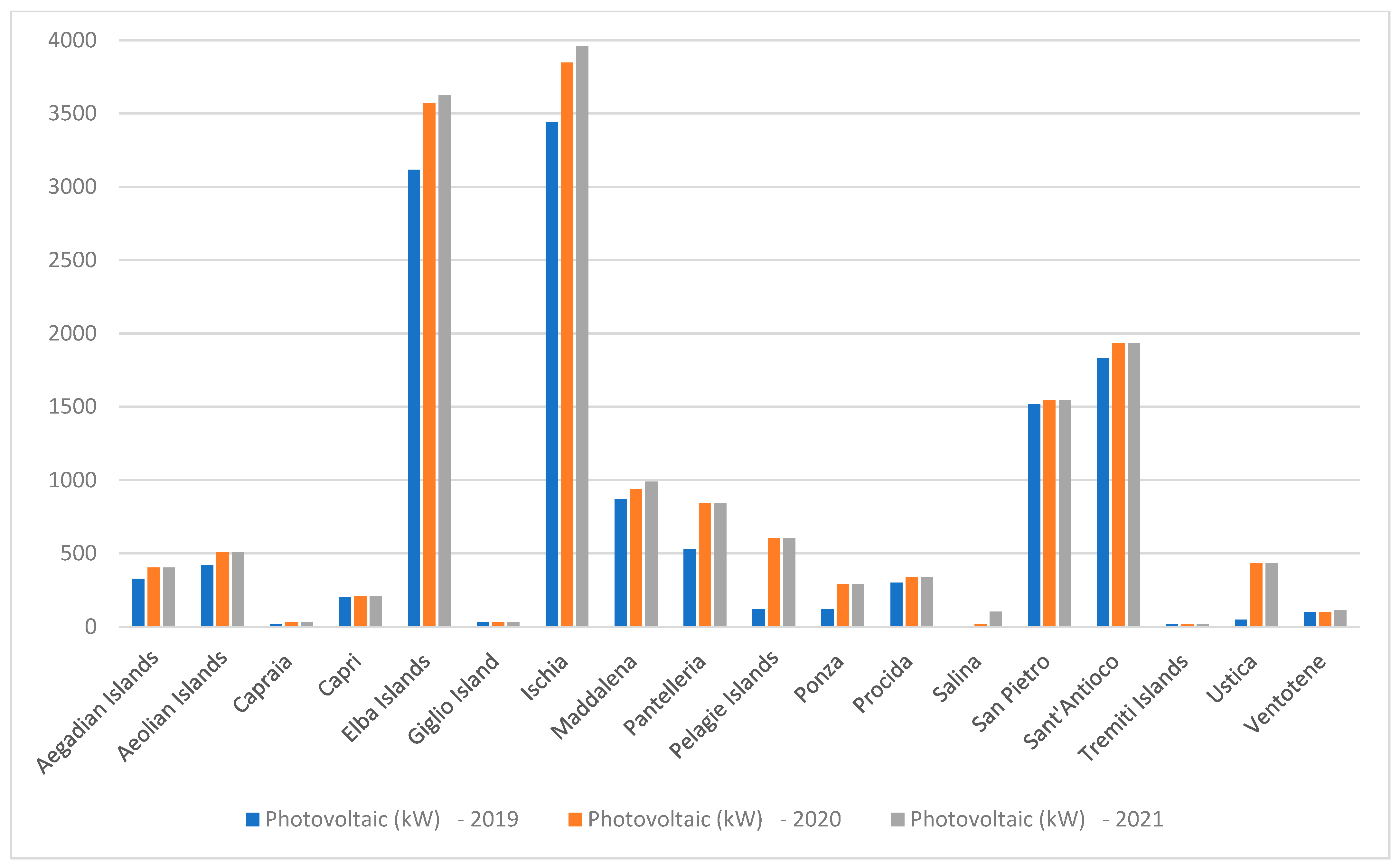
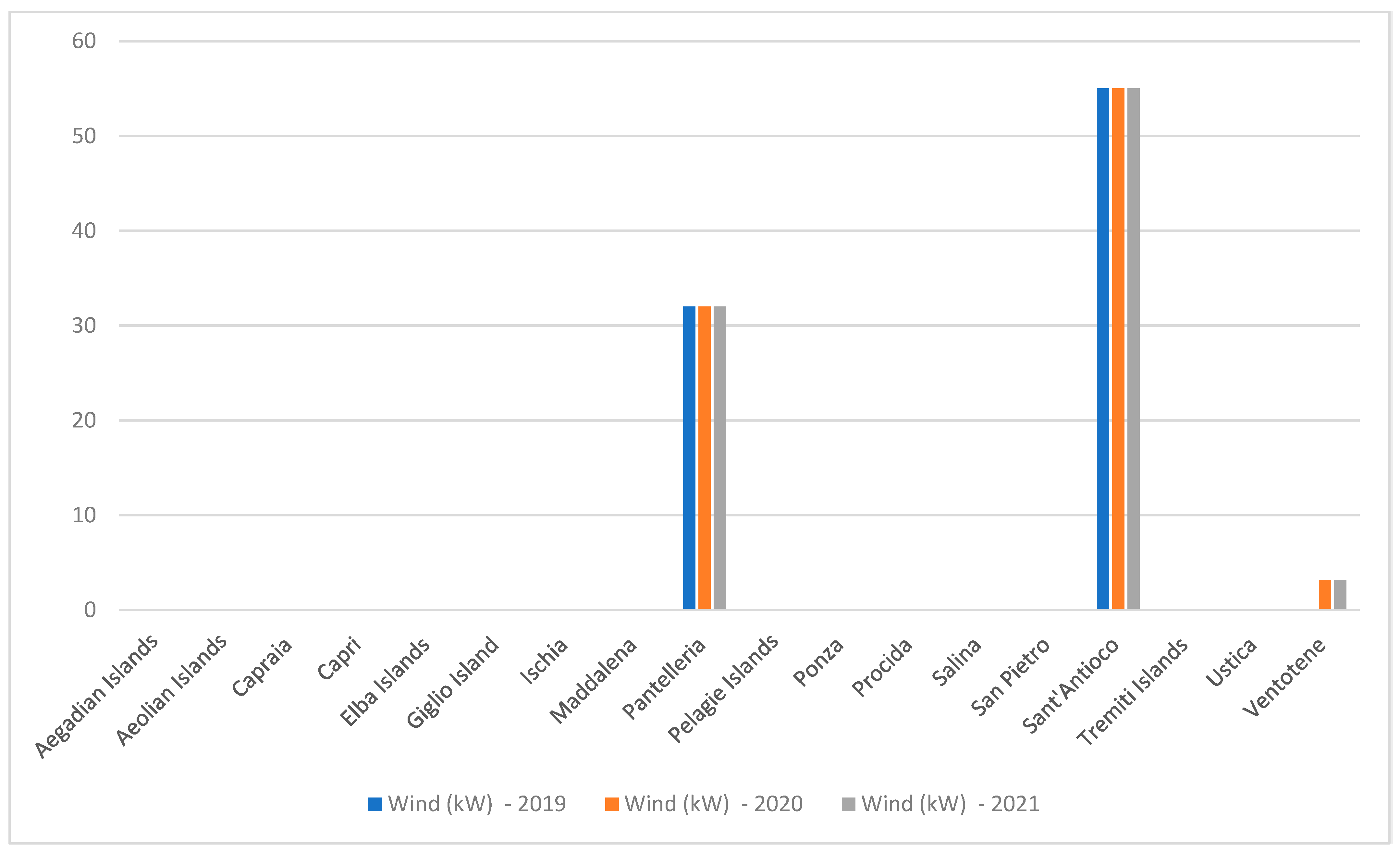

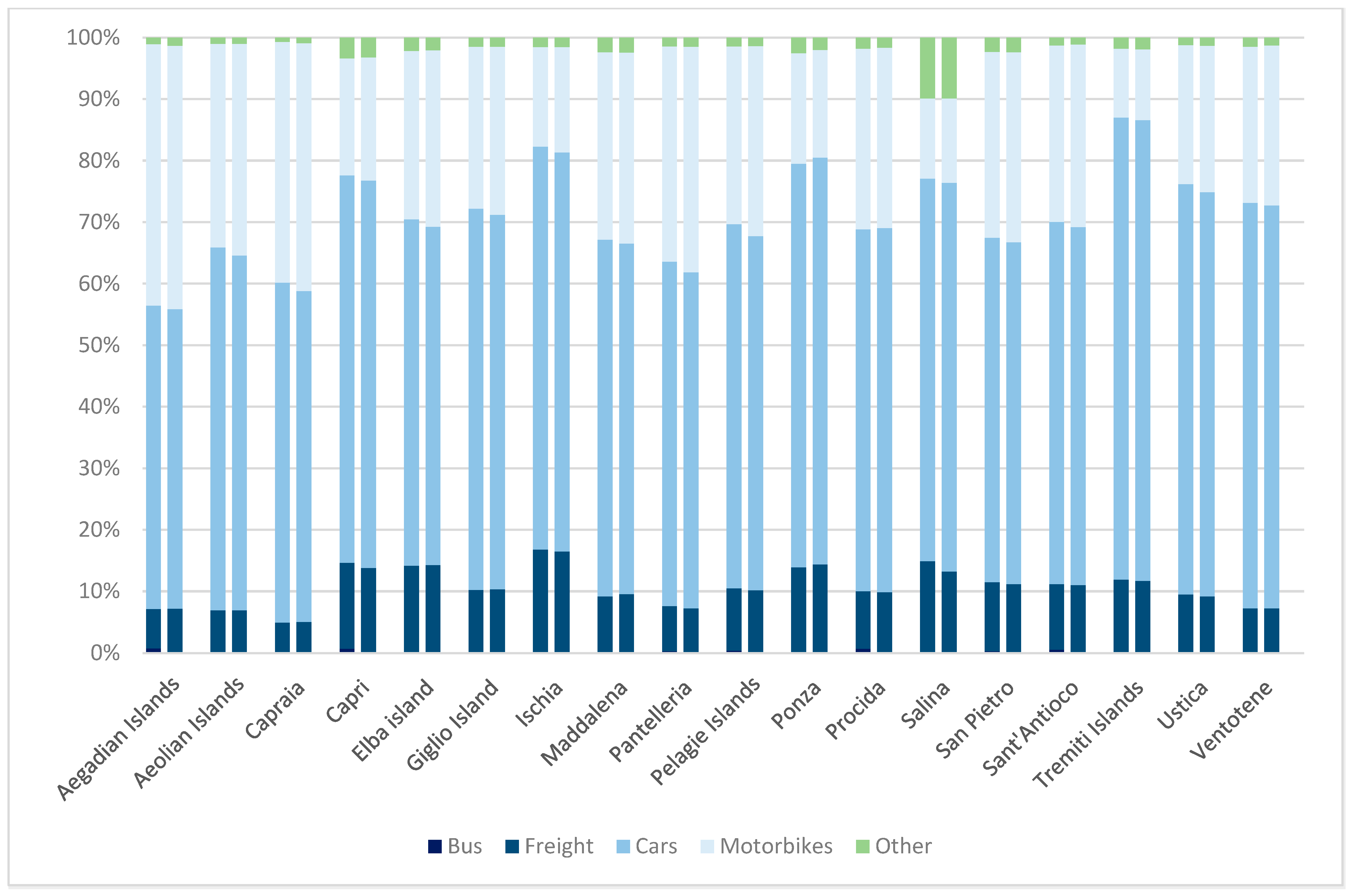
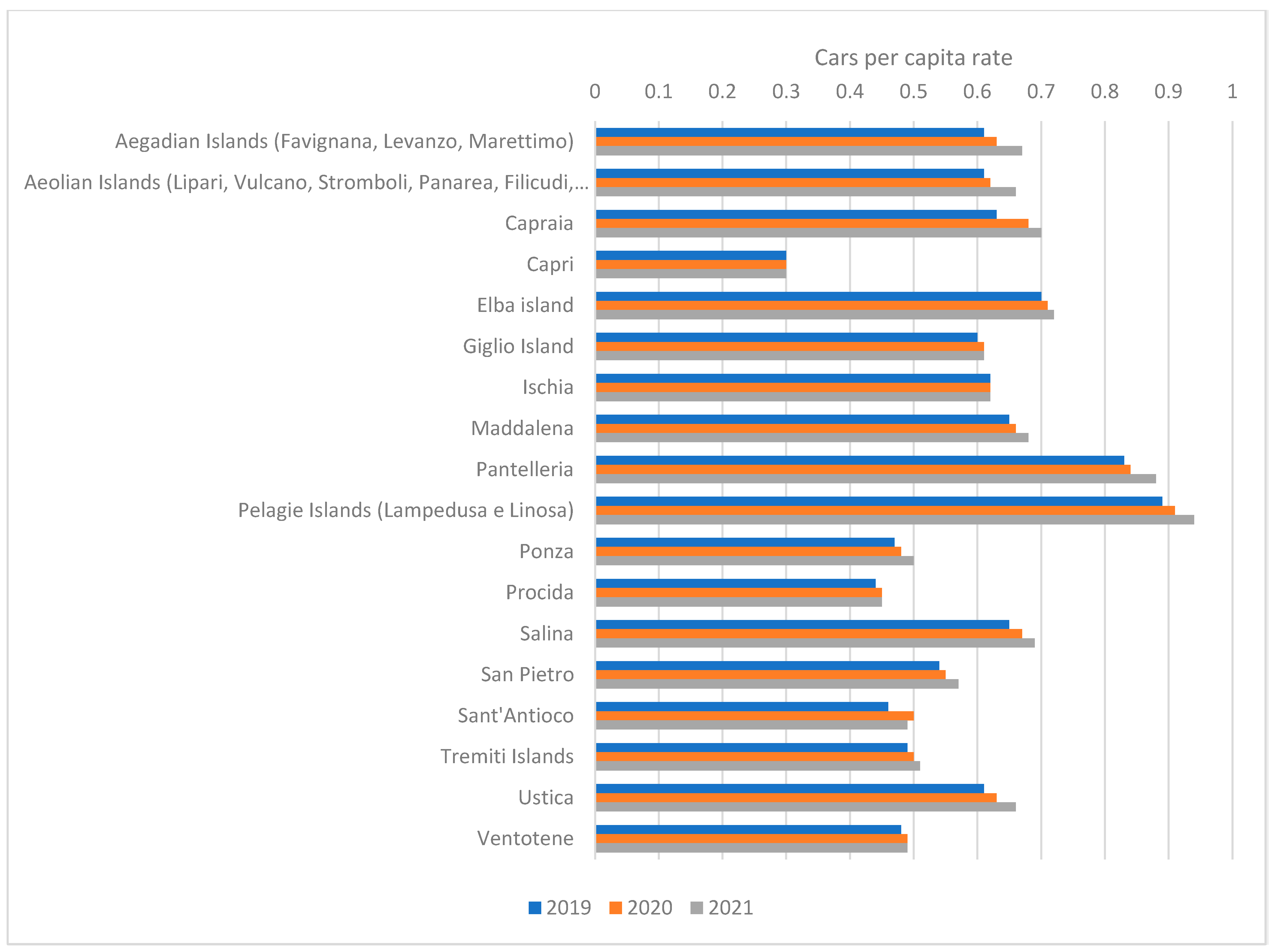
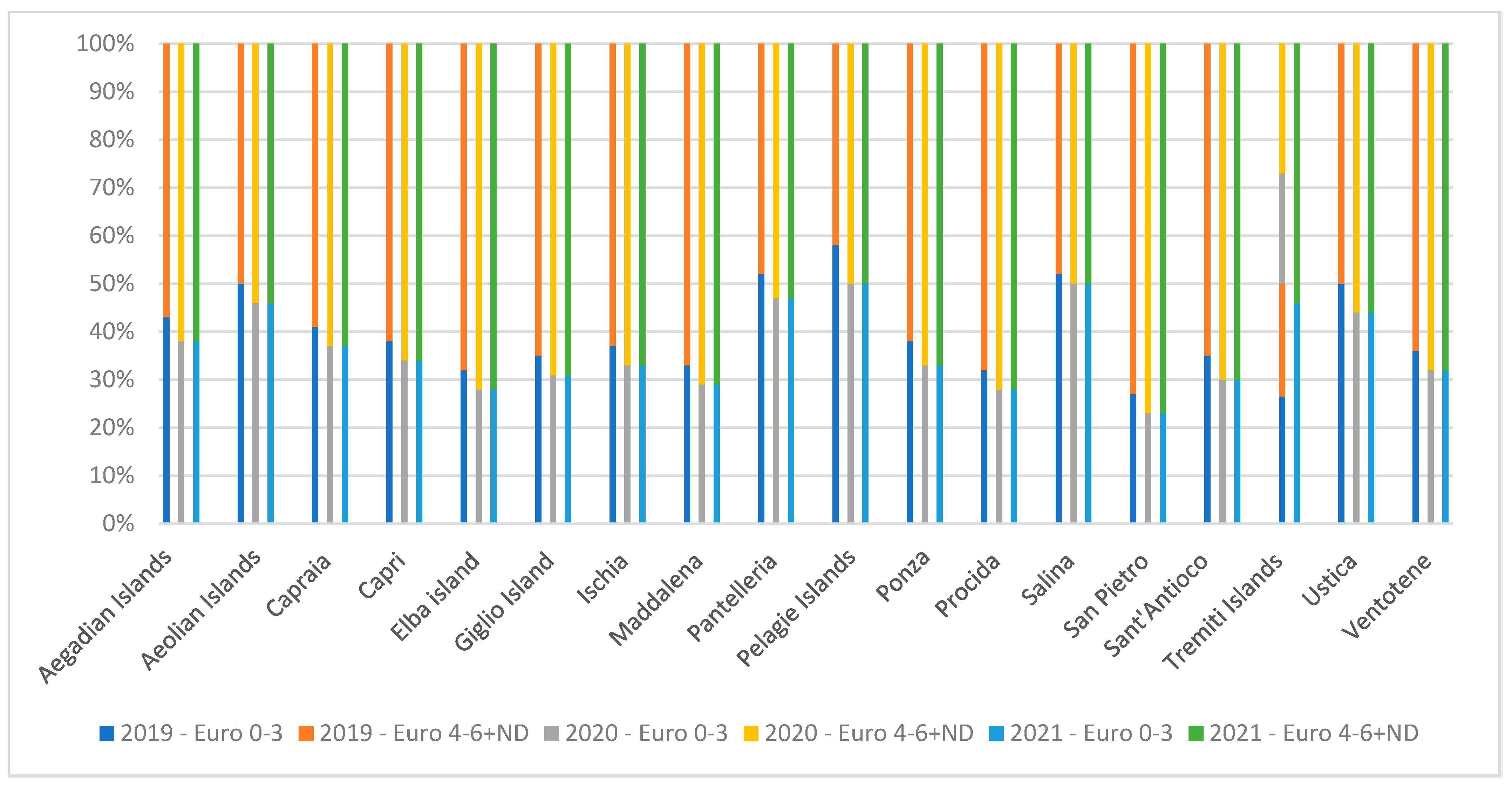
| Source | Data | Years |
|---|---|---|
| ACI | Vehicle fleet and European Emissions Standard Class of car fleet | 2019, 2020, 2021 |
| ISTAT | Number of inhabitants; Islands/Municipal surfaces | 2019, 2020, 2021; 2011 |
| European Commission Urban Waste Water Website | Presence of wastewater treatment, treatment status | 2020 |
| ISPRA | Waste sorting | 2019, 2020, 2021 |
| Municipality websites | Waste collection method | 2021 |
| Local energy management company— Società Elettrica Liparese S.MED.E Pantelleria spa S.EL.I.S. Lampedusa spa Società Elettrica di Favignana spa Società Elettrica Ponzese Enel Produzione Società Impianti Elettrici srl Impresa Elettrica D’Anna Bonaccorsi S.EL.I.S. Marettimo spa Germano Industrie Elettriche S.EL.I.S. Linosa spa I.C.EL. srl | Energy sources | 2021 |
| MiSE Ministerial Decree 14 February 2017 | Annual electricity production from fossil fuels | 2017 |
| GSE | Photovoltaic power installed, wind power installed, and solar area installed | 2019, 2020, 2021 |
| Municipality and water management company websites | Water supply arrangements | 2021 |
| Islands | Power Source | Annual Electricity Production from Fossil Fuels [GWhe/Year] | Energy Management Companies |
|---|---|---|---|
| Alicudi | Diesel generator | 400 | Enel Produzione |
| Capraia | Biodiesel | 2.76 | Enel Produzione |
| Capri | Interconnected with national grid | Enel Produzione | |
| Elba Islands | Interconnected with national grid | - | |
| Favignana | Diesel generator | 15.47 | Società Elettrica di Favignana S.p.A. |
| Filicudi | Diesel generator | 1.4 | Enel Produzione |
| Giglio Island | Diesel generator | 10.3 | Società Impianti Elettrici S.r.l |
| Ischia | Interconnected with national grid | - | |
| La Maddalena | Interconnected with national grid | - | |
| Lampedusa | Diesel generator | 3.766 | S.EL.I.S. Lampedusa S.p.A. |
| Levanzo | Diesel generator | 600 | I.C.EL. S.r.l |
| Linosa | Diesel generator | 2.8 | S.EL.I.S. Linosa S.p.A. |
| Lipari | Diesel generator | 34.8 | Società Elettrica Liparese |
| Marettimo | Diesel generator | 2.04 | S.EL.I.S. Marettimo S.p.A. |
| Panarea | Diesel generator | 3.14 | Enel Produzione |
| Pantelleria | Diesel generator | 44.17 | S.MED.E Pantelleria S.p.A. |
| Ponza | Diesel generator | 11.5 | Società Elettrica Ponzese |
| Procida | Interconnected with national grid | - | |
| Salina | Diesel generator | 9.16 | Enel Produzione |
| San Pietro | Interconnected with national grid | - | |
| Sant’antioco | Interconnected with national grid | - | |
| Stromboli | Diesel generator | 3.92 | Enel Produzione |
| Tremiti Islands | Diesel generator | 3.87 | Germano Industrie Elettriche |
| Ustica | Diesel generator | 4.87 | Impresa Elettrica D’Anna Bonaccorsi |
| Ventotene | Diesel generator | 2.7 | Enel Produzione |
| Vulcano | Diesel generator | 7.28 | Enel Produzione |
| Islands | Annual Electricity Production from Renewable Energy [MWhe/Year] | Annual Electricity Production from Fossil Fuel [MWhe/Year] | Energy Demand Covered by Renewable Sources |
|---|---|---|---|
| Aegadian Islands (Favignana, Levanzo, Marettimo) | 475.23 | 17,510 | 2.64% |
| Aeolian Islands (Lipari, Vulcano, Stromboli, Panarea, Filicudi, Alicudi) | 598.45 | 50,540 | 1.17% |
| Capraia | 41.77 | 2760 | 1.49% |
| Capri | 242.56 | Interconnected with national grid | - |
| Elba island | 4261.6 | Interconnected with national grid | - |
| Giglio Island | 40.81 | 10,300 | 0.39% |
| Ischia | 4657.42 | Interconnected with national grid | - |
| Maddalena | 1164.83 | Interconnected with national grid | - |
| Pantelleria | 1043,5 | 44,170 | 2.31% |
| Pelagie Islands (Lampedusa e Linosa) | 711.62 | 40,460 | 1.73% |
| Ponza | 340.21 | 11,500 | 2.87% |
| Procida | 399.58 | Interconnected with national grid | - |
| Salina | 121.72 | 9160 | 1.31% |
| San Pietro | 1819.54 | Interconnected with national grid | - |
| Sant’Antioco | 2370.14 | Interconnected with national grid | - |
| Tremiti Islands | 21.64 | 3870 | 0.56% |
| Ustica | 508.78 | 4870 | 9.46% |
| Ventotene | 137.41 | 2700 | 4.84% |
| Islands | 2019 | 2020 | 2021 | 2021 | ||||||
|---|---|---|---|---|---|---|---|---|---|---|
| Separate Collection (%) | Separate Collection per Capita (kg/in*Year) | Urban Waste per Capita (kg/in*Year) | Separate Collection (%) | Separate Collection per Capita (kg/in*Year) | Urban Waste per Capita (kg/in*Year) | Separate Collection (%) | Separate Collection per Capita (kg/in*Year) | Urban Waste per Capita (kg/in*Year) | Waste Collection Methods | |
| Aegadian Islands (Favignana, Levanzo, Marettimo) | 72% | 490.19 | 683.29 | 75% | 501.85 | 665.04 | 80% | 581.27 | 729.1 | Ecological platform, road bins, door to door |
| Aeolian Islands (Lipari, Vulcano, Stromboli, Panarea, Filicudi, Alicudi) | 23% | 176.00 | 749.93 | 22% | 151.76 | 678.42 | 39% | 266.73 | 685.47 | Ecological platform, domestic composting, road bins, on-call service |
| Capraia | 42% | 391.65 | 936.41 | 40% | 307.08 | 763.92 | 41% | 366.46 | 897.78 | Ecological platform, domestic composting, road bins, road bells |
| Capri | 61% | 522.93 | 860.75 | 61% | 421.72 | 694.96 | 61% | 484.92 | 791.37 | Ecological platform, domestic composting, road bins, door to door |
| Elba Island | 65% | 586.54 | 906.34 | 63% | 514.53 | 822.77 | 66% | 593.16 | 902.19 | Ecological platform, domestic composting, road bins, door to door |
| Giglio Island | 30% | 320.27 | 1054.39 | 31% | 310.21 | 994.69 | 30% | 316.68 | 1043.08 | ecological platform |
| Ischia | 44% | 284.19 | 650.66 | 41% | 239.08 | 589.99 | 45% | 279.06 | 625.06 | door to door, ecological platform |
| Maddalena | 71% | 506.33 | 713.12 | 68% | 462.49 | 680.99 | 69% | 510.15 | 736.61 | door to door, ecological platform |
| Pantelleria | 71% | 363.72 | 512.49 | 73% | 396.74 | 544.33 | 78% | 451.48 | 577.98 | Ecological platform, domestic composting, road bins, door to door, on-call service |
| Pelagie Islands (Lampedusa e Linosa) | 5% | 46.90 | 926.06 | 11% | 96.70 | 898.99 | 20% | 231.04 | 1158.09 | Ecological platform, road bins, door to door, on-call service |
| Ponza | 9% | 72.22 | 810.50 | 11% | 84.84 | 779.77 | 9% | 73.74 | 834.61 | road bins |
| Procida | 70% | 432.94 | 619.70 | 69% | 426.83 | 618.62 | 71% | 473.83 | 665.57 | Ecological platform, domestic composting, door to door |
| Salina | 51% | 303.72 | 592.07 | 40% | 202.17 | 509.77 | 34% | 33.64 | 98.73 | Road bins, door to door, ecological platform |
| San Pietro | 56.4% | 323.80 | 574.12 | 72.6% | 391.77 | 539.34 | 84% | 478.57 | 571.82 | door to door, ecological platform, on-call service |
| Sant’Antioco | 80% | 381.01 | 477.38 | 82% | 447.00 | 544.73 | 82% | 465.83 | 571.40 | door to door |
| Tremiti Islands | 38% | 275.00 | 717.90 | 55% | 473.81 | 863.30 | 63% | 886.13 | 1404.62 | road bins |
| Ustica | 20% | 82.53 | 409.30 | 13% | 44.40 | 350.52 | 13% | 53.06 | 417.57 | Ecological platform, domestic composting, door to door, on-call service |
| Ventotene | 18% | 120.94 | 681.79 | 24% | 166.51 | 685.34 | 34% | 300.99 | 876.39 | door to door, road bells, on-call service, domestic composting |
| Island | Water Supply Arrangements | Presence of Wastewater Treatment | Type of Wastewater Treatment | Treatment Status |
|---|---|---|---|---|
| Alicudi | Tankers | no | - | - |
| Capraia | Desalinator | no | - | - |
| Capri | Submarine pipelines | yes | more stringent | partial |
| Elba Islands | Submarine pipelines, wells/fresh water sources | yes | more stringent | partial |
| Favignana | Submarine pipelines, desalinator, wells, storage tanks and tankers | no | - | - |
| Filicudi | Tankers | no | - | - |
| Giglio Island | Desalinator | no | - | - |
| Ischia | Submarine pipelines | no | - | - |
| La Maddalena | Submarine pipelines | yes | more stringent | total |
| Lampedusa | Desalinator | yes | Secondary | partial |
| Levanzo | Submarine pipelines and tanks | no | - | - |
| Linosa | Desalinator | no | - | - |
| Lipari | Reverse osmosis desalinator | yes | Secondary | partial |
| Marettimo | Karst water sources being restored, Submarine pipelines and tankers | no | - | - |
| Panarea | Tankers | no | - | - |
| Pantelleria | Desalinator | yes | Primary | partial |
| Ponza | Tankers | no | - | - |
| Procida | Submarine pipelines | yes | ND | partial |
| Salina | Tankers | no | - | - |
| San Pietro | Submarine pipelines | yes | more stringent | total |
| Sant’antioco | Submarine pipelines, wells/fresh water sources | yes | more stringent | total |
| Stromboli | Tankers | no | - | - |
| Tremiti Islands | Tankers | yes | more stringent | total |
| Ustica | Desalinator | no | - | |
| Ventotene | Desalinator | yes | more stringent | total |
| Vulcano | Desalinator and tankers | yes | ND | partial |
Disclaimer/Publisher’s Note: The statements, opinions and data contained in all publications are solely those of the individual author(s) and contributor(s) and not of MDPI and/or the editor(s). MDPI and/or the editor(s) disclaim responsibility for any injury to people or property resulting from any ideas, methods, instructions or products referred to in the content. |
© 2023 by the authors. Licensee MDPI, Basel, Switzerland. This article is an open access article distributed under the terms and conditions of the Creative Commons Attribution (CC BY) license (https://creativecommons.org/licenses/by/4.0/).
Share and Cite
Battistelli, F.; Messina, A.; Tomassetti, L.; Montiroli, C.; Manzo, E.; Torre, M.; Tratzi, P.; Segreto, M.; Chu, C.-Y.; Paolini, V.; et al. Assessment of Energy, Mobility, Waste, and Water Management on Italian Small Islands. Sustainability 2023, 15, 11490. https://doi.org/10.3390/su151511490
Battistelli F, Messina A, Tomassetti L, Montiroli C, Manzo E, Torre M, Tratzi P, Segreto M, Chu C-Y, Paolini V, et al. Assessment of Energy, Mobility, Waste, and Water Management on Italian Small Islands. Sustainability. 2023; 15(15):11490. https://doi.org/10.3390/su151511490
Chicago/Turabian StyleBattistelli, Francesca, Ambra Messina, Laura Tomassetti, Cassandra Montiroli, Eros Manzo, Marco Torre, Patrizio Tratzi, Marco Segreto, Chen-Yeon Chu, Valerio Paolini, and et al. 2023. "Assessment of Energy, Mobility, Waste, and Water Management on Italian Small Islands" Sustainability 15, no. 15: 11490. https://doi.org/10.3390/su151511490
APA StyleBattistelli, F., Messina, A., Tomassetti, L., Montiroli, C., Manzo, E., Torre, M., Tratzi, P., Segreto, M., Chu, C.-Y., Paolini, V., Corsini, A., & Petracchini, F. (2023). Assessment of Energy, Mobility, Waste, and Water Management on Italian Small Islands. Sustainability, 15(15), 11490. https://doi.org/10.3390/su151511490








